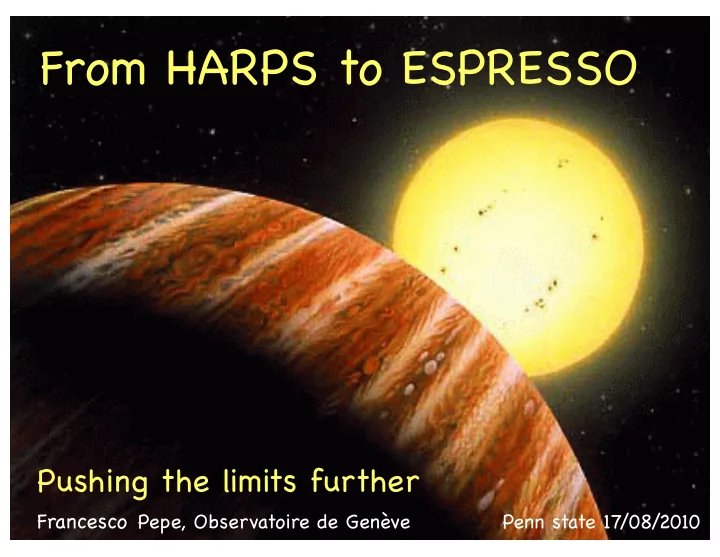

From HARPS to ESPRESSO Pushing the limits further Francesco Pepe, Observatoire de Genève Penn state 17 /08/2010
Where is the limits ?
The HARPS RV machine + final quality ‘real-time’ data reduction
Data reduction facts: Keep on moving Improvements since 2003: Remove atmospheric effects Improve barycentric correction Correct ThAr lines catalog Improve and stabilize wavelength calibration Correct for ‘color’ (continuum) variations and ADC errors Correct for lamp aging Remove background and contamination Improve cross-correlation and masks Integrate laser frequency combs and Fabry-Perots Blaze function correction and ... continuously debug SW!
Example: Blaze correction Echelle grating = variable diffraction efficiency along order Typically 50% less on the border of orders This introduces spectral lines deformations Should be removed by the calibration but : Thorium calibration Star Spectrum
Extreme stability Δ RV =1 m/s Δ RV =1 m/s Δλ =0.00001 A Δ T =0.01 K Δ p=0.01 mBar 15 nm 1/1000 pixel Vacuum operation Temperature control
Stability and repeatability Absolute position on the CCD of a Th line over one month
Detector ‘instabilities’ Marco Gullieuszik, ESO
The two main methods ... Simultaneous reference Self reference Baranne et al., 1996 Butler et al., 1996 ‘HARPS-like’ ‘HIRES-like’ No differential IP changes allowed No differential IP changes allowed Not suitable for slit spectrographs Suitable for any/slit spectrographs No losses, wide wavelength range Absorption, restricted wav. range IP modeling is POSSIBLE REQUIRES ‘de-convolution’
The simultaneous reference
No change of instrumental profile (IP)
Differential illumination variation Slit spectrograph Fiber-fed spectrograph Fiber entrance double scrambler Fiber exit Δ RV up to 3 m/s ! R R 1 arcsec
The concept of double scrambling 1) Scramble stellar image 2) Use telescope pupil as new entrance illumination
Fibers alone do not scramble enough
Octagonal Fiber Near Field Far Field
Scrambling in the near field Circular fiber : Diameter : 70 microns Star size : 35 microns Octagonal fiber : Diameter : 70 microns Star size : 35 microns
Far field effects
The wavelength calibration 580nm 570nm 560nm 550nm 540nm px 0 500 1000 1500 2000 2500 3000 3500 4000
Thorium lamps issues
Improving the calibration Cover full spectral range High spectral resolution (again) Equally dense and unresolved lines No blends Knowledge of theoretical wavelengths Stability (repeatability) of 10 -11 over > 20 years New ThAr atlas Lovis et al. 2007 Murphy et al., 2007 ThAr lamp Laser comb or etalon
Laser frequency comb ! ! Steinmetz et al., 2008 !
Fabry-Perot Calibrator ! !
Better photons or resolution? 1.200 For exact formulae see: I ≅ SNR 2 Butler et al. 1996 1.000 Bouchy et al. 2001 etc. 0.800 Continuum 2 Signal 0.600 A Approximation: 0.400 0.200 RV = Spectral line position 0 -120 -80 -40 0 40 80 120 Fixed-delay Interferometer (Ge et al.) Dispersed FT spectrograh (Hajian et al., 2005, Monnet) Multiplex ‘DIS’advantage Fourier Transform spectrograph (Maillard et al., 2009)
Better photons or resolution? Flux
Better photons or resolution?
Care about ... atmosphere Assumptions: 3% telluric line or (10% error on model depth) R = 100’000 3000 stellar lines, 30% average depth -> 10 cm/s RV error with 1 year period, if one line affected Recommendations Remove ‘generously’ the spectral domains affected by telluric lines Or model the atmosphere
Contamination by faint background sources Bad seeing Good seeing Fiber entrance Possible dispersion up to several 100 m/s RV R Large contamination Small contamination by secondary spectrum by secondary spectrum
Contamination by faint background sources
Steps towards ESPRESSO et al. For precise RVs a lot of photons are required -> bigger telescopes and better efficiency. But sometimes efficiency is in competition with instrumental precision. Improve instrumental precision by Optimize simultaneous reference technique e.g. by further improving stability, in particular of CCDs Reduce illumination effects (scrambling required) New calibration reference needed Understand and master effects by atmosphere, moon, and other contaminants Optimize observation strategy to reduce stellar noise effects Increase spectral resolution (stability, telluric lines, SNR)
Recommend
More recommend